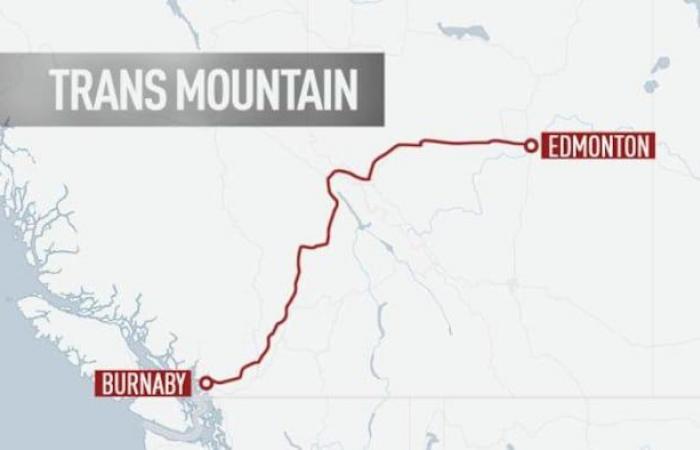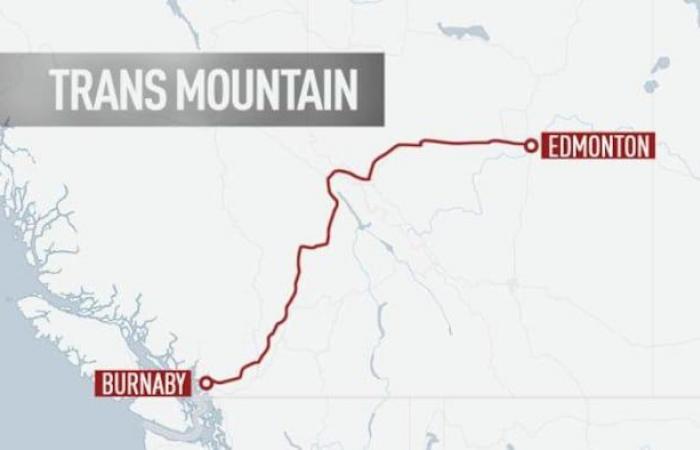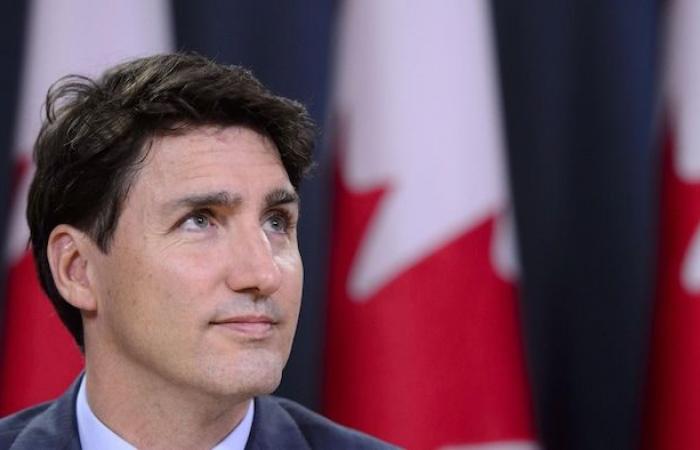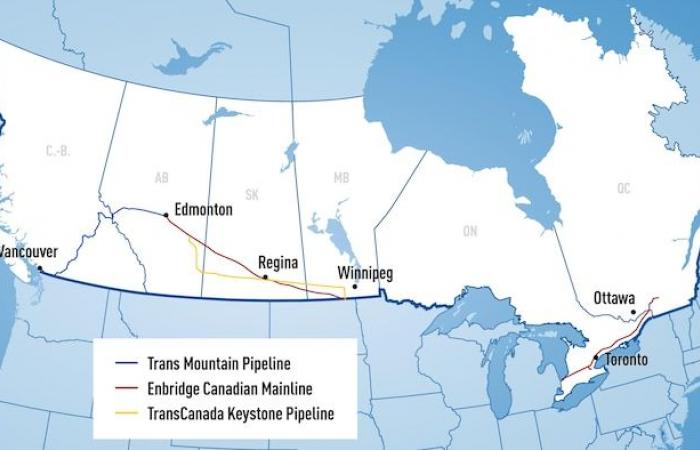A year ago, the Trans Mountain expansion project was officially put into service without ceremony or camera. Since then, the economic and geopolitical situation has changed to the point where projects similar to this pipeline are requested. Trans Mountain, which cost more than $ 34 billion to Canadians, does not, however, fill all its promises.
Without a doubt, the expansion has met numerous expectations of the industry, explains the analyst of S&P Global Commodity InsightsKevin Birn.
The lack of pipes to export oil outside the borders of Alberta forces Canadian producers to sell their barrels at a discount. Before Trans Mountain, this devaluation could reach up to $ 45 per barrel.
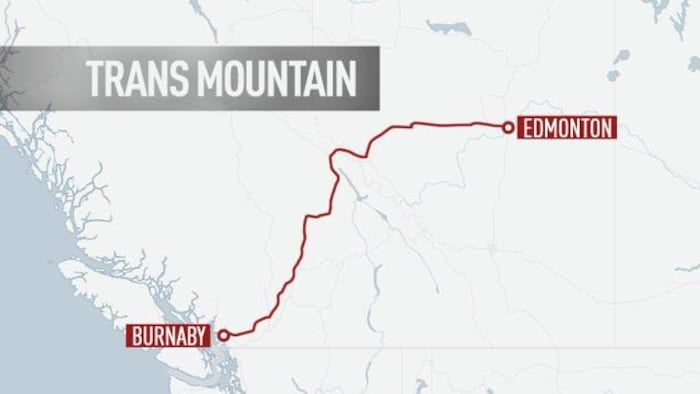
Open in full screen
The Transmountain Agrandi Oloduc can transport up to 890,000 barrels of oil per day.
Photo : Radio-Canada
Since the commissioning, the differential has dropped under the $ 10. We are talking about a system of 5 million barrels per day. The addition is quickly made
underlines Kevin Birn.
He adds that the discount has also stabilized, which made it possible to immunize Canadian producers of recent markets on the market caused by Donald Trump.
Have we celebrated with great fanfare? No. Does he have an impact on the market? Absolutely.
According to data from S&P Globalmore than 50 % of the oil transported in the pipeline goes to Asia, a destination hitherto difficult to access.
If the conquest of this growth market was one of the objectives of the enlargement project, Kevin Birn says that the final destination at the exit of the pipeline matters little. Once oil is in a ship, it can be transported anywhere that offers the best price.
Beginning of the widget. Pass the widget?End of widget. Return to the start of the widget?
Maximization of profits for oil companies? Without a doubt, but not only, replied the professor of economics at the Calgary public policy school, Trevor falls.
In Alberta, a decrease in a dollar from the oil differential provides $ 740 million in additional revenue to provincial chests. He notes that the rest of Canada is indirectly benefiting from the increase in tax revenue.
Profits at $ 34 billion?
These advantages are however accompanied by a substantial invoice assumed by the federal government which owns the project: more than $ 34 billion.
One year after commissioning, opinions still diverge to know if this cost is justified.

Open in full screen
The professor of economics Trevor falls thinks that despite its cost, the pipeline will be paid in the long term.
Photo : Radio-Canada / Jocelyn Boissonneault
Pour Trevor fallsthe answer is yes. According to his calculations, the income generated by the pipeline will cover the activity costs and the vast majority of repayment generated debt. Even if Ottawa tries to sell the infrastructure, the economist thinks that there is a good chance that a private company will take debts.
He adds that the trade war with the United States and concerns related to Canada’s energy sovereignty also increased the value of the pipeline, the only one to export elsewhere than to the United States.
If we want to diversify our business, we need infrastructure and each project will have its share of risk
he explains.
The lesson to be drawn from experience with the United States is that any alternative solution is very precious for many years.
The professor at the Environmental and Resources Management School at Simon Fraser University, Thomas Guntonhas a completely opposite opinion.
The federal government and therefore the taxpayer may lose around $ 18 billion in the project
he believes.
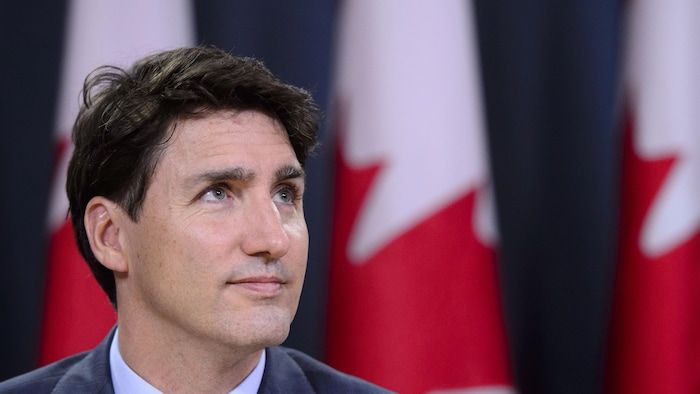
Open in full screen
The government of Justin Trudeau bought the Trans Mountain project in 2018 for $ 4.5 billion.
Photo: Canadian press / Sean Kilpatrick
He notes that the rights imposed for the moment on oils to transport their product in the pipeline are much higher than the rights of other competitors and largely subsidized by Ottawa.
Even if the United States imposes a tariff on Canadian oil, it remains more advantageous for oil to sell south of the border.
The price of diversification is too high.
Reuters has shown that the pipeline is much less used than what the Crown Business had provided in particular because of the rights requested. This year, the company anticipates an 80 % use rate, much below 96 % planned.
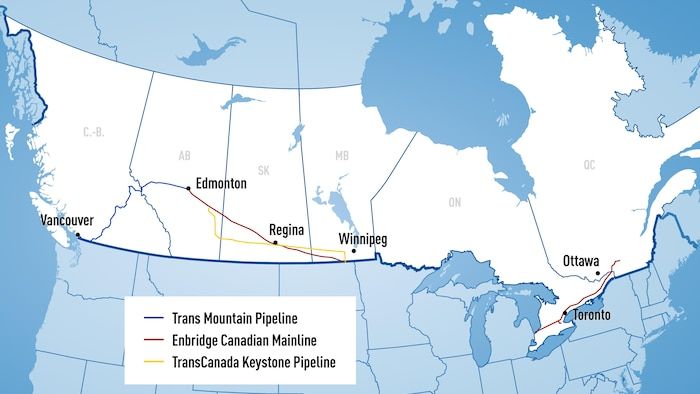
Open in full screen
Rights paid by oil to pipeline companies are half a lesser for the Enbridge oil pipeline that Trans Mountain.
Photo : Radio-Canada
Trevor falls explains the divergence of views on the use of the long -term pipeline. There is a risk, but I tend to think that pipeline will continue to be used long after 2040.
Global demand is not high enough to justify an expansion of Canadian oil production
argues for his part Thomas Gunton.
Who is right? The answer will not be known for several years.
An indigenous participation that is long overdue
There is another promise that is also still unfinished: that of an indigenous participation in the pipeline.
We are waiting for the government to decide to sell
explain Stephen Masonthe director of Project Reconciliationa group that claims to represent 120 first Nations interested in becoming the owner of Trans Mountain.
Without a doubt, First Nations should have this infrastructure.
The group presented its first purchase proposal almost six years ago, but the federal government first wanted to complete the construction of the project.
One year after commissioning, Project Reconciliation is still interested, but the schedule on the federal side is not clearer. We have to agree on the commercial value [du pipeline]
,, that Stephen Masonwhich cannot be done before the hearings on the toll rights planned this year, but several times postponed.
The president of Project ReconciliationRobert Morin, however, believes that the pipeline will have helped launch the conversation on indigenous participation in these major energy projects.
With Reuters information

